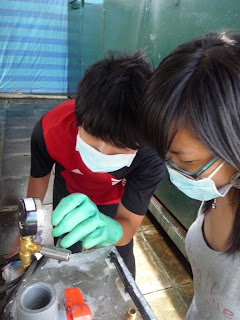 0
comments
Wednesday, November 25, 2009
0
comments
Wednesday, November 25, 2009
 0
comments
Wednesday, November 25, 2009
0
comments
Wednesday, November 25, 2009
 0
comments
Friday, November 20, 2009
0
comments
Friday, November 20, 2009
Third week of our planting.
 0
comments
Tuesday, November 17, 2009
0
comments
Tuesday, November 17, 2009
During our course of our 1st prototype run, we had begun to notice the flaws in the material and the job done on the prototype. This eventually led to undesired consequences and interruptions within the 20 day run.
 0
comments
Monday, November 16, 2009
0
comments
Monday, November 16, 2009
Gas Test Checking
Before conducting the aerobic digestion run, we had to do a gas check first.
1. Close V7 to prevent any more gas from entering the methane capture system.
2. Insert the Drager tube into the gas test socket.
3. Ensure V4 is open.
4. Open V5 to allow the gas to fill up the gas test socket.
5. Drag the tube using the Drager pump to measure the concentration of gases inside
6. Close V5 after measurement is obtained.
After the gas test checking, we proceeded to conduct the Aerobic Digestion. The procedures performed by us are as follows
Aerobic Digestion
Before conducting the aerobic stage, We ensured that the valves leading to the 1st chamber (Anaerobic stage) are closed. They are V1, V2, V4, V5, V6, V7, and V8.
1. Crack open vent valve V9 to allow natural atmospheric balance for digesting, the close it. Open V10 slightly then fully to measure the pressure of the system.
2. Open V11 and run Fish Tank Pump to allow aeration.
3. Start Heating Coil and maintain at 60oC by Thermostat control
4. Manually stir the sludge in the 2nd chamber
5. Leave sludge for approximately 10 days
6. After the completion of the process, collect sample by opening V3 and closing it after all the sludge has dropped into the bottom containment.
7. Stop Fish tank pump, Heating Coil, thermostat control.
8. Close all valves and perform housekeeping
As observed, the waste had become more liquid, and the solids have disintegrated into the surrounding liquid. The colour of the waste mixture had also changed from a darker brown to a lighter brown. Even though still rather smelly, the smell seemed less pungent.
For this run, it was much better than the loading as all the waste had been contained. But problems on the digester prototype started to appear to us during our transferrence of sludge to the 2nd chamber below. As seen from Fig 6, there is leakages at the middle tube between the two chambers. The side and bottom of the 2nd chamber also started to leak as the level of the waste in the 2nd chamber increased. Immediately, we asked for some of the technicians to come down to rectify the problem. The problem was assumed recitified for that day after the technicians had sealed it with a different silicon, and the leaks seemed to have stopped.
 0
comments
Friday, November 6, 2009
0
comments
Friday, November 6, 2009
Our Second week of plant growth
 0
comments
Wednesday, November 4, 2009
0
comments
Wednesday, November 4, 2009
COLLECTION OF WASTE
The procedures for the experimental run on the prototype were developed weeks ahead and are as follows:
Anaerobic Digestion
1. Collect sample of the raw sludge before loading.
2. Ensure that all valves are closed.
3. Load sludge through the loading port and open V1 to allow sludge to enter the 1st Chamber and close V1 after loading is completed.
4. Open V8 to allow any liquid to be drained from the 1st chamber towards the liquid drain.
5. Ensure that there is a container at the other side of the filter to collect the filtrate.
6. Ensure that the tubing connecting the methane capture system and digester between V12 and V7 is connected.
7. Open V12 and V7 to allow gases to pass through to the methane capture system.
8. Stir the sludge in the chamber manually to ensure even mixing.
9. Open V4 slightly first then fully to measure the pressure using the pressure gauge attached.
10. Leave the system to run for approximately 10 days





























